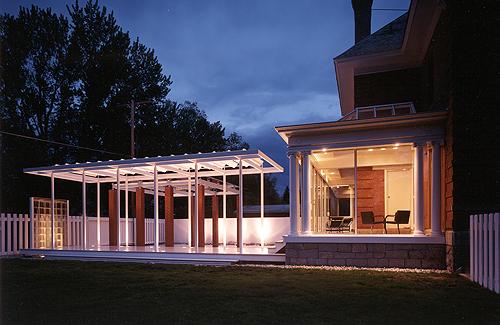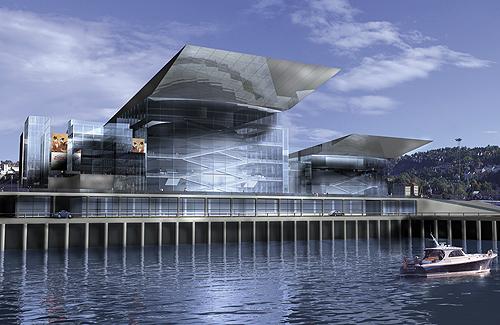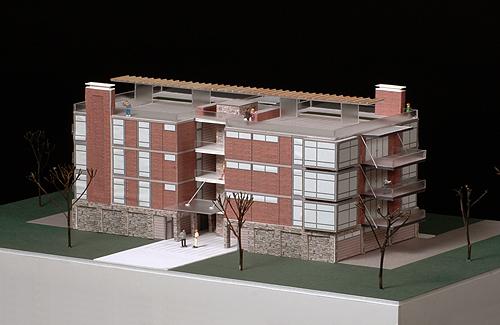Montana People - Thomas Bitnar
Architect...

Celebrating nine years in Bozeman, the Czech-American architect talks about his Western heroes and his modernist views of architecture in Montana.
If you ask Thomas Bitnar about his Western heroes, actor Gary Cooper and architect Fred Willson come to the tip of his tongue. They are men who helped define his childhood dreams and his professional philosophy.
Born in Czechoslovakia in 1948, under a newly established Communist rule, Bitnar grew up seeing his father accused of being a regime adversary and sentenced to 25 years in prison. For the young Bitnar, who, under Communism, was allowed to see few Western movies except High Noon, Gary Cooper became a romantic icon of the wild and free West, a good guy who always prevailed against bad.
Bitnar, too, prevailed during Communist rule in Czechoslovakia, playing cowboys and Indians and setting up a teepee in the family garden. Later, he studied architecture at CVUT – Prague Technical University, where he received his grounding in the International Style, Czech Functionalism and the Bauhaus, with their austere, minimalist approach to design.
While Adolf Loos, Mies van der Rohe and Le Corbusier became his architect heroes, Bitnar could not ignore the architecture in the city in which he lived. Prague embodied ten centuries of architectural history, from the Romanesque to the contemporary. In addition, his great-grandfather had designed castle interiors for the Romanian King of Sinai. “So, both the aristocratic luxury and ornamentation of the old architecture and the functional minimalist designs of modern architecture became influences on my own approach to design,” Bitnar says.
Crossroads of the World
New York City was the place where Bitnar dreamed of putting those design concepts into reality. He saw New York as the crossroads of the world, the city that encompassed all cultures, and the place he wanted to practice architecture.
In 1979, Bitnar escaped from Communist Czechoslovakia and spent a year in Germany, soaking up more of the Bauhaus influence. But in 1980 he immigrated to the U.S., where he spent the next 16 years living and working in New York City.
In the climate of large architecture firms, including HOK, Perkins and Will and Spector Group, Bitnar was a member of design teams working on office buildings and banks. But after a decade of gaining professional experience with these firms, he opened his own practice with offices in New York and Prague in 1990. And in 1996 he moved to Bozeman, after helping establish the School of Architecture at The Technical University in Liberec, his hometown in the Czech Republic.
Of the experience, he says in the Czech journal Development News. “It was fantastic. I like when something new is forming. Unfortunately, the complicated bureaucracy made me feel a foreigner in my own country, and overpopulated Europe drove me to the place of my childhood dreams, to the Wild West.”
Wild West
Bozeman was a logical place to realize his dreams. Like Liberec, it is a university town; the Bridger Mountains reminded him of home, and his childhood hero, Gary Cooper had lived in Bozeman for a time. In addition, Bitnar says, “We bought a house that looks like those in Liberec.”
The house Bitnar and his wife Randle bought to raise their young family was a 1904 Queen Anne-Colonial Revival style home designed by John Link. Link was a German born and educated architect who had immigrated to Denver and then Butte, where he employed a young architect, Fred Willson, fresh out of the Ecole des Beaux-Arts in Paris. Willson was soon to become another Western hero for Bitnar.
Bitnar’s first project in Bozeman was the renovation of the Link house, a process that blended old and new with the unique modernist vision he has applied to all of his architectural designs in Montana and elsewhere.
After restoring two floors of the house to their original historic elegance, he turned the third floor ballroom into a modern architecture studio. “I also added a breakfast room, a conservatory and a pergola, blending the historic proportions and some architectural details of the original building with the modernist vocabulary and austerity of steel and glass. I wanted to blend the 20th Century with the 21st Century,” Bitnar says.
“In the process, I learned to work and design in the vocabulary of the 1900s. And in dealing with local suppliers and contractors, I learned about regional materials and construction practices.”
By the time the project was completed and Bitnar’s office was open for clients, the renovation had received an award from the Historic Preservation Board, earned a spot on the House and Garden channel and subsequently has been written up in Western Interiors and Design.

New Hero
During these first years in Bozeman, Bitnar was also learning more about the vast influence Fred Willson had on the historic architecture of Bozeman.
“Fred Willson became one of my heroes. He designed over 1600 buildings in Montana, many in Bozeman. Thanks to Willson, Bozeman has great architectural diversity. People with money and a dream – influential people in Bozeman – would come to him and say, ‘I like this style or that style. Design me a good building.’ And Willson did.”
As a result Bozeman has examples of Mission Revival, Mediterranean Revival, Craftsman style, French chateaux, Georgian style and even Bauhaus designs.
“Fred Willson reacted to every client’s style, needs and taste,” says Bitnar. “So each of his buildings is different and original. In my practice, I have also tried to create original and innovative designs for each of my clients. When I’m asked to design a building, I try to understand my client’s heritage, culture and history to create a beautiful space in which proportion, color and light are in harmony.
“Architecture is team work. The client is an essential player who must show dedication and sensibility. Without the Medicis, there would be no Michelangelo,” he says with a twinkle in his eyes.
Using this philosophy, Bitnar has spent the past six years working with clients on all facets of architectural design, including urban development, affordable housing and commercial and residential architecture.
New Urbanism
In contrast to Bitnar’s work on his own house in an historic urban district of Bozeman, his work on The Village Downtown brings the concept of “new urbanism” to the city. “The design process took a year and a half and could have only happened with sophisticated clients,” Bitnar says of the project that aims to integrate a new neighborhood into the fabric of downtown and residential Bozeman in a way that prevents suburban sprawl and isolation from downtown amenities.
“Inside, the buildings are very modern and open, but outside there are many historical precedents,” Bitnar says. “The townhouses, the first phase of the project, draw on elements of a Fred Willson designed Georgian style house on Willson Avenue. And the street running through the Village represents the layout and dimensions of 8th Avenue. There are also alleys with garages in back of the houses, similar to those in Bozeman’s historic districts.”
The project demands a combination of many disciplines – architectural design, interior design, landscaping design, street design. “That is what architecture is all about,” Bitnar says.

Social Responsibility
Architecture also includes social responsibility, which Bitnar has become involved with through affordable housing projects resulting from his friendship with client Dab Dabney.
“Affordable housing shouldn’t mean bad architecture; it shouldn’t mean cheap architecture,” Bitnar says. “It should create dignity, security and order for residents. And it should be integrated with the rest of the city.”
Bitnar’s original design for affordable housing was very modern in appearance. “Dab rejected that,” Bitnar laughs. His final design, with a large sloped roof and plumbing and electrical infrastructure concentrated in chimney-like structures, gives the appearance of an English county house.
“We built it for $75 a square foot with Walker Construction; the average cost of residential construction is $120 to $125 a square foot,” Bitnar says with pride.
Commercial Modernism
But ask Bitnar what his favorite project has been in the last six years and he will tell you about the Avis car rental building on Route 10 near Gallatin Field.
“It represents how I think about architecture. It’s very rational. The shape uses the vocabulary of the region – a box with a shed roof – it could be a rancher’s equipment building. But the purpose of the building is to rent modern cars, products of the 21st Century. So why not have this represented by materials of the 21st Century. Not rusted tin and weathered boards, but metal, plastic and glass.
“It’s a kind of billboard architecture because it is selling cars. You need to be able to read AVIS when you’re driving past at 60 miles an hour. But it’s also a stage in front of the mountains. It’s a composition.”
Bitnar’s design of the Avis building, featured in the Spring 2005 issue of The New York Times Style Magazine, seems to have moved architectural modernism into the heart of the Gallatin Valley, to the wonderment of some residents.
Bitnar’s modernism is also evident in his design of the Galusha Higgins and Galusha office building on Last Chance Gulch in Helena. “After only six years of practice in Montana, to have a building on the main street of the capitol of a state that’s larger than Germany is something of which I’m very proud.”

Quietly Residential
All of Bitnar’s buildings are not large or commercial or urban, however. In a recent rural residential project near the Gallatin River, he used the concept of a bridge and its expectations of the sights and sounds of water and accompanying landscapes to create a home with a similar relationship with its surroundings.
In every room you can see what’s going on outside. There are three buildings, like three bridges, each angled to take advantage of the views and joined with transparent connectors. You are never lost in the building because you can always see out both sides, like a bridge.”
Before settling on the final design, Bitnar went so far as to stake out the footprint of the house on the ground, complete with the position of windows and furniture, in order to take advantage of all the views while still keeping the house intimately connected with the landscape.
Architectural Exercises
Not all of Bitnar’s projects are built, nor does he expect them to be. In Europe, he explains, the designs of most public buildings are decided by competitions open to everyone. The public views models of the designs and has an influence on the architectural jury during public hearings. Many architects enter their design knowing the likelihood of having it chosen is slim. Still, it is part of the personal challenge and continuing education that European architects expect in their practice and that Bitnar expects in his own. He has participated in almost 30 national and international competitions including a design for the new opera house in Oslo, Norway.
Recently he took on the challenge of analyzing how he could save Bozeman’s historic train depot in a design of the new public library that maintained the historic precedent in Western towns of having buildings front directly in Main Street. Although the design was not used, Bitnar says the project allowed him to employ his own aesthetic principles that combine the influences of both historic and modern architecture.
In a similar non-built project, Bitnar designed a hotel at the entrance to Big Sky that helped him study, understand and translate into modernism the vocabulary of Western national park architecture.

Shared Perspective
While Bitnar is a perpetual student of architecture, he’s also a part-time teacher with an adjunct assistant professorship in the Architecture Department at Montana State University. “I’m a big advocate of education. I have spent over ten years at universities getting three Masters degrees. When I got my Masters at Columbia University in New York, I was already 44 years old. So, I understand the perspective of the student.
“Some of my students work in my office after graduation, but after about a year I try to find them jobs elsewhere in the West or East or abroad. They can always come back, but they need to get a broad perspective.”
The Modernist
With Bitnar’s own broad perspective gained by living and practicing architecture in Prague, New York and Bozeman, he sees architecture influencing all levels of people’s lives. “Architecture must be reactive and reflective. It must be ‘green,’ sustainable and intelligent. Architects have a responsibility to understand environmental impact, reduce energy, reduce cost, accentuate natural light, and use ecological and recyclable materials. We are responsible for creating a better working and living environment. Why? Because architecture is a mirror of society; it represents who we are.”
Ask Bitnar to translate his architectural philosophy into the ideal architecture for Montana, and he gives you a modernist’s answer.
“For me, Montana’s architecture is about the extraordinarily beautiful landscape and open space. So it means the ideal architecture for Montana is an absolutely transparent building, an invisible exterior and an interior without barriers, a seamless glass object where through the ceiling you see the sky, through the walls you see the landscape and through the floor you see the earth.”
~ Sam Curtis, a freelance writer for over 30 years, writes for national and regional magazines including Audubon, E The Environmental Magazine, Western Interiors and Design, Backpacker and Field & Stream.
Leave a Comment Here
Leave a Comment Here